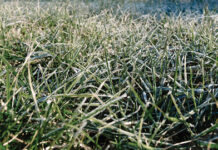Whether it’s preparing customer properties for spring, ongoing maintenance, or troubleshooting problems, soil testing is often a highly recommended step in many aspects of landscape care. But how many actually perform such tests? And further, how many are confident in interpreting the results? Without these skills, you could be missing out on crucial information that could make your job a lot easier—and differentiate yourself from competition.
The soil test report for a lawn or garden soil sample will mean little unless you understand the terms and numbers used. As a lab agronomist with Spectrum Analytic, Inc. for the past 20 years, I not only conduct soil and plant tissue analysis, but train others in how to read the results. The Spectrum Analytic soil test report (seen below) includes the analytical results and a graphic representation of those results—including the status levels and nutrient recommendations—if requested. Most soil test reports will be in a similar format with some small differences. This article will provide definitions of terms and acceptable ranges, which should help you in planning a soil management program.

Soil pH
The term pH is used to express the acidity or alkalinity of the soil and is measured on a 0 to 14 scale. Seven is neutral, while values below 7 are acidic and values above 7 are alkaline. The pH is important because it affects the availability of nutrients in the soil that are essential for plant growth.
The availability of most nutrients is best at a pH of 6.2 to 6.8. When the pH is higher, micronutrients such as iron (Fe), manganese (Mn), boron (B), copper (Cu), and zinc (Zn) become less available. This is because soil pH affects the solubility of plant nutrients in the soil—some become more soluble as pH increases, others as pH decreases.
Most turf grass, flowers, ornamental shrubs, fruits, and vegetables grow best in slightly acid soils of pH 6.1 to 6.9. Some plants require even more acidic soil for best growth. These include rhododendron, azalea, pieris, mountain laurel, some wildflowers, some conifers, and blueberries, which grow best at a pH between 4.9 and 5.5.
Soil pH can be raised by adding lime (CaCO3) or lowered by adding elemental sulfur (S) or iron sulfate (Fe2SO3). Don’t arbitrarily add these materials to your soil to change the pH unless soil test recommendations indicate such amendments are needed. Also, don’t expect a long-term change in pH, since soil tends to return to its native pH over time. Therefore, landscape plants, as well as turf, should be selected based on the existing pH, rather than trying to manipulate pH to suit the plants. On the other hand, planting beds lend themselves more readily to the regular addition of amendments, including lime or sulfur.
Buffer pH (BpH)
Soil pH measures active acidity or alkalinity, while the buffer, which measures total soil acidity, determines the actual lime requirement. The lower the buffer pH, the more the soil will resist a change in pH. Therefore, more lime will be required to raise the pH to the desirable level. The acceptable buffer pH range is 6.8 to 7.0.
P, K, Ca, Mg Levels
Phosphorus (P), potassium (K), calcium (Ca), and magnesium (Mg) are important plant macronutrients that are required in relatively large amounts for optimum plant growth. The presence of these macronutrients is expressed in ppm (parts per million). Acceptable ranges for these elements are shown as follows:

Available P and Exchangeable K, Ca, and Mg refer to the approximate amount of each element that is expected to become available to the plants over a normal growing season.
Cation Exchange Capacity (C.E.C.)
C.E.C. is a measure of a soil’s capacity to hold exchangeable nutrients that have a positive electrical charge (cations), such as hydrogen (H+), calcium (Ca++), magnesium (Mg++), and potassium (K+). The CEC is expressed in meq/100 gms of soil. Soils with a high C.E.C. can supply large amounts of nutrients. However, they also require large amounts of fertilizer to be considered “fertile.” Low C.E.C. soils, such as sand, have low nutrient holding and supplying power. Therefore, more frequent applications of low rates of fertilizer are normally preferred.
Both clay and organic matter serve as potential sources of nutrients by attracting cations. Soils with large amounts of clay or organic matter have higher exchange capacities than sandy soils, which are usually low in organic matter. Much more exchange capacity, however, is provided by the presence of even moderate amounts of organic matter, which also benefits the soil in other ways, such as improving soil tilth, or its physical condition as related to supporting plant growth. This is why organic matter amendments are so valuable in many cases.
The approximate range for C.E.C. that can be expected with different soil textures are as follows:

Base Saturation
Base saturation is the percentage of total C.E.C. occupied by the basic cations calcium, magnesium, and potassium. The ease with which cations are absorbed by plant roots increases with the degree of base saturation. In slightly acidic to neutral soils, calcium and magnesium account for 80% or more of the exchangeable cations, while potassium accounts for only a small percentage.
Saturations are more of a secondary effect when it comes to soil testing. The most important part for landscapers is to try to have the nutrient levels within the optimal range. But know that there will be variation within the range, and you shouldn’t attempt to try to achieve a specific saturation level. The percent base saturation of these cations usually will be within the following ranges:
Sulfur (S), Boron (B), Zinc (Zn), Manganese (Mn), Copper (Cu),
and Iron (Fe)
Micronutrients are basically needed only in very small amounts by plants for internal reactions. While they can sometimes be found included with N, P, and K fertilizers, they can also work best foliarly applied in some situations, such as when the soil has a pH of greater than 7.3. In recent years, applying sulfur to soils has become more prevalent in an effort to lower soil pH. But keep in mind that some soils have a naturally high soil pH due to glacial deposition, a seashell deposit, or a marl deposit. In situations like this, you will likely only get a temporary lowering of the soil pH. On the report, each element is reported in parts per million (ppm). The copper and manganese recommendations are derived from a proprietary formula that calculates the effects of other soil factors on availability.
Sodium & Soluble Salts
Sodium is reported both as parts per million (Na ppm) and percent saturation (Na Sat %). Sodium is not a nutrient and is typically a major component of the soluble salts value (explained below). High levels of sodium are detrimental to both plant growth and soil structure, and many of the guidelines are based on the percent saturation of sodium. Sodium is generally found in western soils, which have lower amounts of annual rainfall. But high sodium can also occur in areas where ice melt products are regularly used in snow and ice control on roadways. Generally a sodium saturation of less than 10% is not an issue. With a saturation of 10% to 15% there will be damage to some plants. Saturations levels greater than 15% will cause damage to almost all plants.
Soluble salts are reported as a measurement of electrical conductance of the soil solution called millimhos/centimeter (mmhos/cm). This value increases as the salt content of the soil increases. High levels of soluble salts are generally damaging to plant growth. However, plant tolerance of soluble salts is highly variable between species. In general, for most plants a level of less than 1.0 mmhos/cm is acceptable for normal growth.
Nitrate-N (NO3-N)
Nitrate-N is the predominant form of nitrate used by most plants. It is also the form most easily lost through adverse environmental and soil conditions. The level of nitrate reported is NOT used in the nitrogen recommendation due to the many variables that can affect ultimate plant availability.
Texture
Soil texture refers to the percentage of sand, silt, and clay contained in the soil. The proportions of these components determine the name assigned to the soil (sandy loam, silty clay, etc.) as identified in the U.S. Department of Agriculture textural triangle. The name of the texture is reported in one column, with the percentages of sand, silt, and clay in the following columns. This information has several applications, but is probably used most frequently to identify drainage characteristics of the soil.
In the golf course industry there’s a more in-depth texture analysis that mainly looks at the relative size of the predominant sand particles in the different areas of a golf course. However, this type of analysis is generally not needed for general plant and lawn health.
Recommendations
Nutrient recommendations are made in pounds per 1,000 square feet of the element or oxide listed. Lime is recommended in pounds per 1,000 square feet of 100% calcium carbonate equivalent (CCE) material.
Samples from established turf should be taken to a depth of 3″. Other samples should be taken to a depth of 6″ to 8″. For this reason, ornamental reports have an assumed sampling depth of 7″; while turf samples and reports alone have an assumed sampling depth of 4″. Corrections should be made for actual purity of lime, fineness of grind, and depth of sample. The philosophy behind fertilizer recommendations at Spectrum Analytic is to: 1) recommend enough nutrients to produce a healthy turf or plant where nutrients are not the limiting factor, and 2) when the soil test level of a nutrient is less than optimum, or “Good,” recommend additional nutrients to correct the soil test over a period of time.
It’s important to remember that nutrients like lime, phosphorus, and potassium are not highly soluble and will take a longer period of time to reach the “Good” range when products are not mixed with the soil. All recommendations are assumed to be a broadcast application, unless otherwise noted. Rates should be adjusted for the application method used, and the actual land area that is fertilized. (In the Spring print edition of Turf, I will explain the math that goes into converting soil test results into a determination of what type and amount of fertilizer is actually the best fit.)
Soil tests are not a miracle cure to a better landscape. But they are a reliable beginning to examine if soil is out of balance in nutrients or if soil pH is too acidic. By taking small steps in applying the necessary fertilizers to achieve a more balanced soil, over time there will be improvements in plant health. Then, soil testing can be used for ongoing monitoring of nutrient levels. This will not happen overnight because the soil did not get out of balance overnight. Patience is key in achieving the right soil for the right site.
Urbanowicz is chief agronomist at Spectrum Analytic Inc. He holds a Master’s degree in soil and plant nutrition and is a Certified Professional Agronomist. Spectrum Analytic is based in Washington Court House, OH and performs various types of testing—including soil, plant tissue, fertilizer, lime, and more—for clients nationwide.
Read a follow up article by Urbanowicz — “From Soil Report To Solution” — published in the Spring 2021 Issue of Turf.
Do you have a comment? Share your thoughts in the Comments section below or send an e-mail to the Editor at acosgrove@groupc.com.











![[VIDEO] Dickies®: Discover Workwear That’s Anything But Uniform](https://turfmagazine.com/wp-content/uploads/2023/06/1647663814-4b1a2a7742790a9b1e97a3b963477850192e1d6a9dfba9b07214a77bae25d6e3-d-218x150.jpg)































![[VIDEO] Dickies®: Discover Workwear That’s Anything But Uniform](https://turfmagazine.com/wp-content/uploads/2023/06/1647663814-4b1a2a7742790a9b1e97a3b963477850192e1d6a9dfba9b07214a77bae25d6e3-d-324x160.jpg)